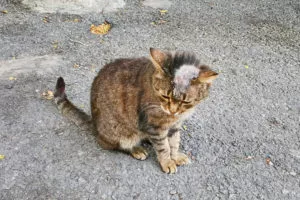Have you noticed your cat is losing hair? Maybe you’ve noticed a few bald patches on your cat that weren’t there before. A change in your cat’s health may feel worrisome, but fur loss can actually be quite a common issue.
Cats can experience balding for various reasons, but the common culprit is external parasites or bacteria, allergies, stress, anxiety, overgrooming, and thyroid problems or genetic conditions.

What to Look for with Bald Spots on Cats
First, what do bald patches look like on your cat? Balding can vary in appearance and can range from large swaths of no hair to tiny, mismatched patches. Depending on the cause, there may also be coinciding scabbing or irritated skin.
Why does my cat have bald patches?
The visible occurrence of balding in cats may have many causes, thus it’s important to consult with a veterinary expert to help determine the exact reason. Some of the most common causes of fur loss in cats are fleas and other external parasites, ringworm, overgrooming, stress, anxiety, allergies, depression, thyroid problems, or genetic conditions.
External Parasites
The most common causes of cat hair loss are external parasites, such as fleas or mites. In this case the balding will be localized, often on the back near the tail. This is luckily an easy fix and hair regrowth will occur quickly once treated. It is important to maintain your cat’s health by keeping up with regular tick and flea control to rule those pests out as a possible reason for future hair loss.
Ringworm
There are many misconceptions surrounding ringworm. Ringworm is in fact a fungal infection that is very contagious and can live up to 2 years. Visible symptoms of ringworm include circular lesions on the skin and thinning or loss of hair. If you think your cat may be suffering from ringworm, please seek veterinary care immediately.
Stress, Anxiety and Overgrooming
If your cat is constantly licking, biting, or cleaning themselves, they may be overgrooming. Overgrooming is often triggered by stress and anxiety; however in rare cases it’s also been correlated with neurological disorders in older cats. It’s important to curb overgrooming before it becomes a daily habit.
Intervention is one of the most effective treatments for overgrooming. Try to interrupt the behavior in a calm manner. Treats or playtime offer the perfect distraction. Keep your cat mentally stimulated and try to redirect overgrooming behaviors as soon as you notice them.
Physical Pain
Some cats may feel muscle or joint pain under their skin. This may cause them to lick the area to soothe the pain. When this behavior is done in excess, your cat can lick away their fur, causing hair loss or a bald spot.
Allergies and Thyroid Issues
Just like us, our feline friends can also feel allergy season starting. Reactions to an allergen can result in dry skin, blisters, and of course, hair loss. The most common source of allergies for cats is contact with certain plants. Another common allergen can be food-related, so it is important to consult with the vet before making any changes to your cat’s diet.
Thyroid issues relate to the unbalancing hormones within the body and are very common. One symptom can be hair loss. Luckily, hyperthyroidism and hypothyroidism can be easily detected in blood tests. Treatments include veterinarian-prescribed medications, and in rare cases surgery.
Genetics
Another cause of hair loss can be hereditary factors. Hair loss is often sporadic in hereditary conditions yet tends to grow back within a few weeks. It’s also fairly common that some cats have naturally thinning hair, particularly in areas around their head or where they frequently rub up against things. Fur loss can be natural, as some cats have no hair at all, so bald patches don’t always strictly indicate a serious condition.
Alopecia
Congenital alopecia occurs most often in younger cats and is related to cat breed or genetics, and it stems from underlying illness, skin disease, allergies, or parasites. More severe symptoms that may coincide with hair loss and indicate a more serious underlying illness include: vomiting, lethargy or changes in appetite.
The first steps to diagnosing cat alopecia begins with a detailed medical history of the cat and a veterinarian performing a physical exam. After this initial phase, your veterinarian will likely perform one or more of the following diagnostic tests: fungal culture, cytology, skin scraping, skin biopsy, bloodwork, urinalysis, allergy testing, or imaging with ultrasound or X-ray.
Treatments for Balding in Cats
Depending on the source of the hair loss, there are many treatments available. For parasites, one may be prescribed medical shampoos, topical therapy, ointments, or parasiticide treatments.
Other treatments include antibiotics, elimination diets, medications, steroids, and environmental enrichment. Environmental enrichment can be provided by improving access to food, water, litter, playtime and interactive toys. If stress cannot be mitigated and is a contributing factor, it may be best to use the cone collars to prevent excessive licking and grooming and preserve the skin to prevent future infection.
After proper treatment, your cat’s hair will very likely grow back in a matter of a few weeks. If you want to check up on your cat’s hair growth progress, you can perform a weekly exam at home.
Using a fine-toothed comb and parting the hair to examine individual sections, inspect your cat’s bald spots and hair loss patches to see if hair is growing back. If needed, take photos to document the date and progress of the hair growth.
Conclusion
It’s important to always consult with a veterinarian regarding any hair loss concerns. Although hair loss in cats is common, it can be a sign that there is an even bigger issue.
If you have any questions regarding your cat’s balding or hair loss, feel free to reach out to Caring Hearts Animal Hospital! Our Matthews, NC animal hospital is here at 704-893-2799 for any questions!
